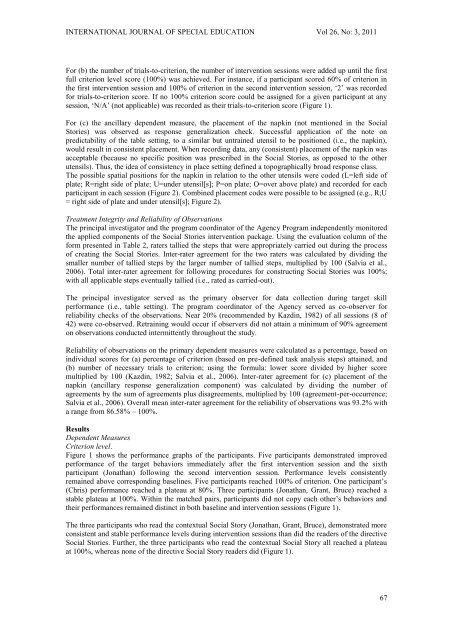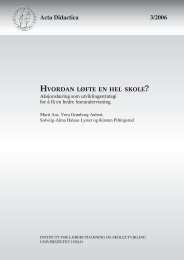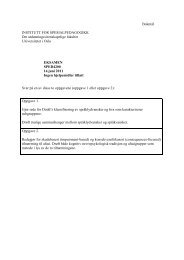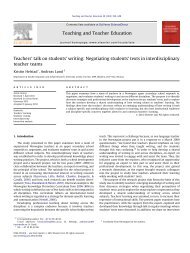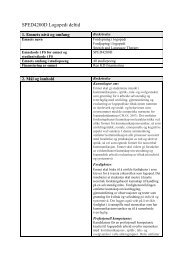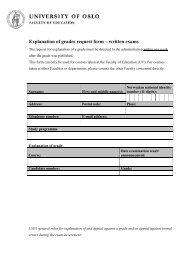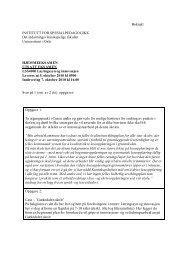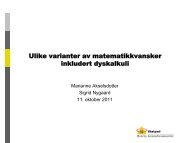International Journal Special Education
International Journal Special Education
International Journal Special Education
Create successful ePaper yourself
Turn your PDF publications into a flip-book with our unique Google optimized e-Paper software.
INTERNATIONAL JOURNAL OF SPECIAL EDUCATION Vol 26, No: 3, 2011For (b) the number of trials-to-criterion, the number of intervention sessions were added up until the firstfull criterion level score (100%) was achieved. For instance, if a participant scored 60% of criterion inthe first intervention session and 100% of criterion in the second intervention session, ‘2’ was recordedfor trials-to-criterion score. If no 100% criterion score could be assigned for a given participant at anysession, ‘N/A’ (not applicable) was recorded as their trials-to-criterion score (Figure 1).For (c) the ancillary dependent measure, the placement of the napkin (not mentioned in the SocialStories) was observed as response generalization check. Successful application of the note onpredictability of the table setting, to a similar but untrained utensil to be positioned (i.e., the napkin),would result in consistent placement. When recording data, any (consistent) placement of the napkin wasacceptable (because no specific position was prescribed in the Social Stories, as opposed to the otherutensils). Thus, the idea of consistency in place setting defined a topographically broad response class.The possible spatial positions for the napkin in relation to the other utensils were coded (L=left side ofplate; R=right side of plate; U=under utensil[s]; P=on plate; O=over above plate) and recorded for eachparticipant in each session (Figure 2). Combined placement codes were possible to be assigned (e.g., R;U= right side of plate and under utensil[s]; Figure 2).Treatment Integrity and Reliability of ObservationsThe principal investigator and the program coordinator of the Agency Program independently monitoredthe applied components of the Social Stories intervention package. Using the evaluation column of theform presented in Table 2, raters tallied the steps that were appropriately carried out during the processof creating the Social Stories. Inter-rater agreement for the two raters was calculated by dividing thesmaller number of tallied steps by the larger number of tallied steps, multiplied by 100 (Salvia et al.,2006). Total inter-rater agreement for following procedures for constructing Social Stories was 100%;with all applicable steps eventually tallied (i.e., rated as carried-out).The principal investigator served as the primary observer for data collection during target skillperformance (i.e., table setting). The program coordinator of the Agency served as co-observer forreliability checks of the observations. Near 20% (recommended by Kazdin, 1982) of all sessions (8 of42) were co-observed. Retraining would occur if observers did not attain a minimum of 90% agreementon observations conducted intermittently throughout the study.Reliability of observations on the primary dependent measures were calculated as a percentage, based onindividual scores for (a) percentage of criterion (based on pre-defined task analysis steps) attained, and(b) number of necessary trials to criterion; using the formula: lower score divided by higher scoremultiplied by 100 (Kazdin, 1982; Salvia et al., 2006). Inter-rater agreement for (c) placement of thenapkin (ancillary response generalization component) was calculated by dividing the number ofagreements by the sum of agreements plus disagreements, multiplied by 100 (agreement-per-occurrence;Salvia et al., 2006). Overall mean inter-rater agreement for the reliability of observations was 93.2% witha range from 86.58% – 100%.ResultsDependent MeasuresCriterion level.Figure 1 shows the performance graphs of the participants. Five participants demonstrated improvedperformance of the target behaviors immediately after the first intervention session and the sixthparticipant (Jonathan) following the second intervention session. Performance levels consistentlyremained above corresponding baselines. Five participants reached 100% of criterion. One participant’s(Chris) performance reached a plateau at 80%. Three participants (Jonathan, Grant, Bruce) reached astable plateau at 100%. Within the matched pairs, participants did not copy each other’s behaviors andtheir performances remained distinct in both baseline and intervention sessions (Figure 1).The three participants who read the contextual Social Story (Jonathan, Grant, Bruce), demonstrated moreconsistent and stable performance levels during intervention sessions than did the readers of the directiveSocial Stories. Further, the three participants who read the contextual Social Story all reached a plateauat 100%, whereas none of the directive Social Story readers did (Figure 1).67


